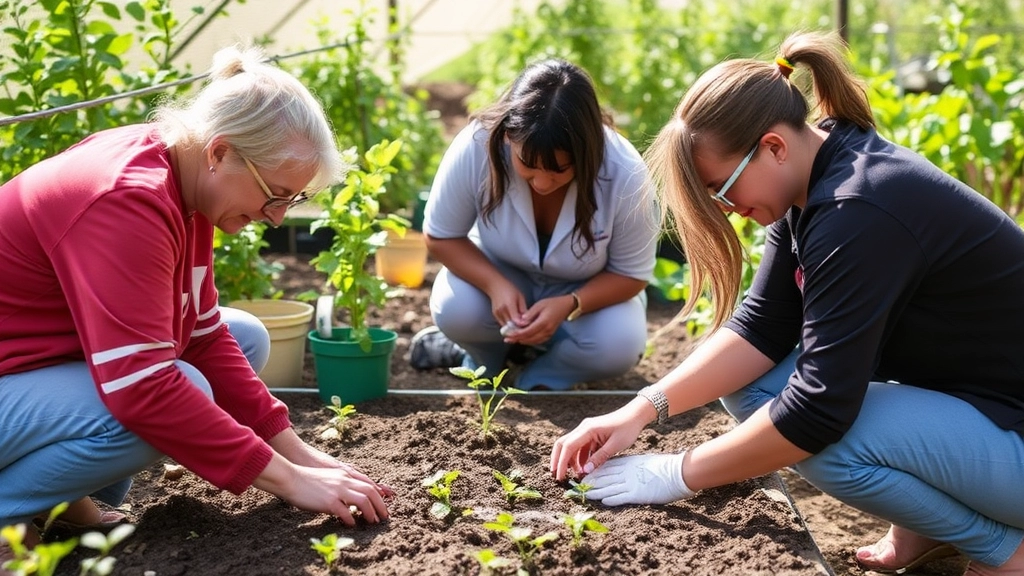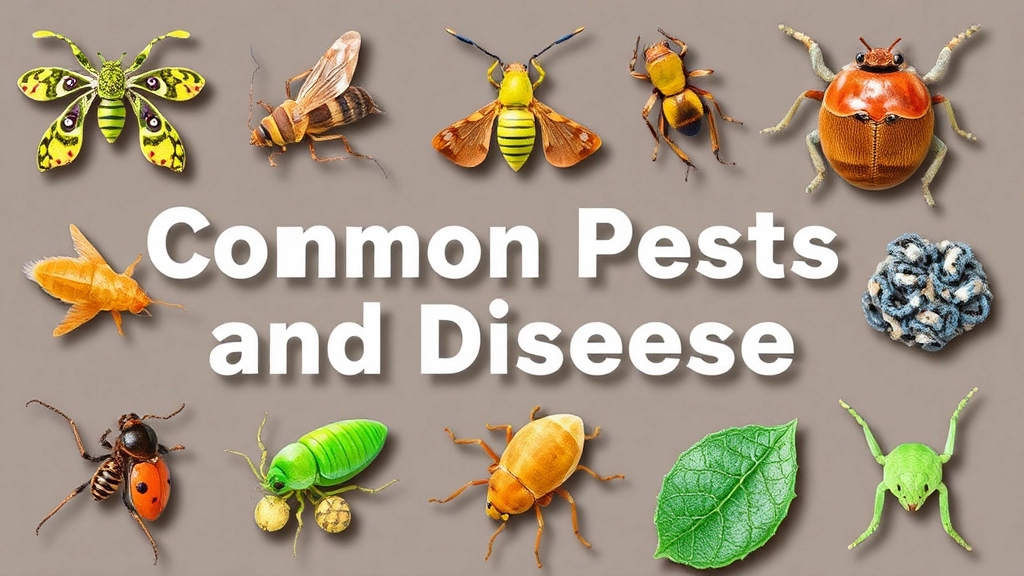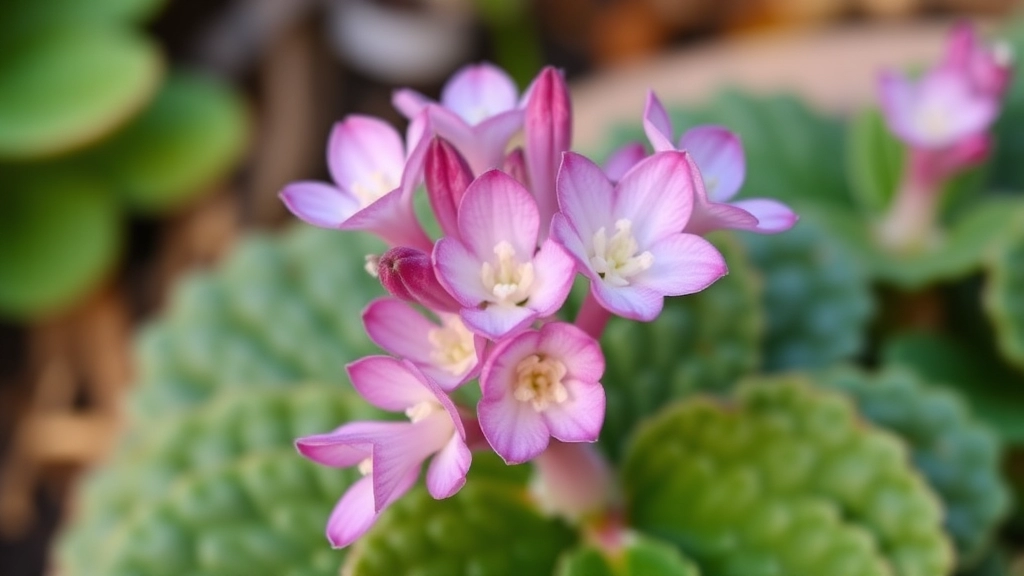Welcome, plant enthusiasts!
Today, we’re diving into the fascinating world of Kalanchoe viguieri, a unique succulent that’s captured the hearts of gardeners worldwide. This Madagascar native is not your average houseplant – it’s a resilient beauty with thick, fleshy leaves and an eye-catching appearance that’s sure to turn heads.
In this article, we’ll explore everything from Kalanchoe viguieri‘s natural habitat and physical characteristics to its growing conditions, propagation methods, and common care challenges. Whether you’re a seasoned green thumb or just starting your plant journey, you’ll find valuable insights to help this remarkable succulent thrive in your space. Let’s uncover the secrets of this charming plant together!
Overview of Kalanchoe viguieri
Hey there, plant lovers! Let’s chat about Kalanchoe viguieri.
This succulent’s a real gem in the Kalanchoe family.
Native to Madagascar, it’s got a unique look that’ll turn heads.
I’ve been growing these for years, and let me tell you, they’re tough cookies.
Kalanchoe viguieri’s not your average houseplant – it’s got character.
Think of it as the rebel of the succulent world.
It’s got thick, fleshy leaves that store water like a champ.
And those flowers? When they bloom, it’s a real show-stopper.
But here’s the kicker – it’s not just pretty. It’s practical too.
I’ve used it in rock gardens, and it thrives in spots where other plants throw in the towel.
Curious about how to care for this bad boy? Stick around, and I’ll spill all the secrets.
Trust me, once you get to know Kalanchoe viguieri, you’ll be hooked.
It’s a plant that keeps on giving, without asking for much in return.
Now that’s what I call a win-win in the plant world!
Natural Habitat and Distribution

Let’s dive into where Kalanchoe viguieri calls home, shall we? This funky little succulent’s got a pretty specific address, and it’s not your average backyard.
Native Stomping Grounds
Kalanchoe viguieri is a Madagascar native. Yeah, that island off the coast of Africa that’s basically nature’s playground. It’s like this plant decided to set up shop in one of the coolest biodiversity hotspots on the planet.
Where You’ll Spot It
- Southern Madagascar: This is where you’ll find most of these guys hanging out.
- Rocky areas: They love a good rocky outcrop or cliff face.
- Dry forests: These plants are tough cookies, thriving in arid woodland areas.
Climate Preferences
Think hot and dry. Kalanchoe viguieri is all about that desert life, but with a twist:
- Warm temperatures year-round
- Low rainfall
- High sun exposure
But here’s the kicker â it’s adapted to deal with occasional bursts of rain. Smart plant, right?
Conservation Status
Now, I’ve got to level with you. Madagascar’s unique flora is under threat, and Kalanchoe viguieri is no exception. Habitat loss is a real issue, making these plants rarer in the wild.
Why It Matters
Understanding where Kalanchoe viguieri comes from is crucial for growing it successfully. It’s like knowing your friend’s background to get why they act the way they do. This info helps us recreate its natural conditions and keep it happy in our homes or gardens.
So, next time you’re looking at your Kalanchoe viguieri, imagine it basking in the Madagascar sun, clinging to a rocky cliff. That’s its true home, and that’s the vibe we’re aiming for when we grow it.
Remember, Kalanchoe viguieri’s natural habitat shapes everything about it â from its water needs to its sunlight preferences. Keep this in mind, and you’ll be well on your way to being a Kalanchoe viguieri whisperer. If you’re interested in other Kalanchoe species, you might want to check out the uses of Kalanchoe blossfeldiana or learn about the varieties of Kalanchoe tomentosa.
Physical Characteristics of Kalanchoe viguieri
Let’s dive into what makes Kalanchoe viguieri stand out in the succulent world.
Ever seen a plant that looks like it’s straight out of a sci-fi movie? That’s Kalanchoe viguieri for you.
This bad boy’s got some seriously cool features:
Leaves:
- Thick and fleshy (typical succulent style)
- Oval-shaped with a pointy tip
- Edges are wavy or slightly serrated
- Greyish-green colour that’s hard to miss
Stem:
- Woody and sturdy
- Can grow pretty tall, up to 1-2 meters in the right conditions
Flowers:
- Small and bell-shaped
- Usually yellow or orange
- Bloom in clusters at the top of the plant
Overall shape:
- Upright and branching
- Looks a bit like a mini tree or shrub
Here’s the kicker – Kalanchoe viguieri’s got this unique, almost alien-like appearance.
It’s not your average garden plant, that’s for sure.
The leaves store water like a champ, making it super drought-resistant.
Fun fact: Some folks call it the “chandelier plant” because of how the leaves hang.
Bottom line: Kalanchoe viguieri’s physical characteristics make it a real eye-catcher.
Whether you’re a plant newbie or a seasoned green thumb, this succulent’s gonna turn heads.
Growing Conditions and Care

Alright, let’s chat about how to keep your Kalanchoe viguieri happy and thriving. Trust me, it’s not rocket science, but there are a few key things you’ll want to nail down.
Light and Temperature
First up, these succulents are sun-lovers. They’re like that friend who’s always chasing the perfect tan. Here’s the deal:
- Bright, indirect light is their sweet spot
- A few hours of direct morning sun? They’ll lap it up
- Too much harsh afternoon sun? That’s a no-go, mate
Temperature-wise, they’re pretty chill (pun intended):
- Ideal range: 15-24°C (59-75°F)
- Can handle brief dips to 10°C (50°F)
- Anything below that? Time to bring ’em indoors
Soil and Watering
Now, let’s talk dirt. These guys aren’t fussy, but they do have preferences:
- Well-draining soil is a must
- Mix regular potting soil with sand or perlite
- Aim for a 50/50 ratio
Watering is where most folks mess up. Remember, these are succulents:
- Let the soil dry out between waterings
- Water deeply, then forget about it for a while
- In winter, cut back even more
Fertiliser and Pruning
Feeding your Kalanchoe viguieri isn’t complicated:
- Use a balanced, water-soluble fertiliser
- Feed once a month during growing season
- Skip the fertiliser in winter
As for pruning, it’s more about maintenance than anything:
- Remove dead or yellowing leaves
- Pinch off leggy growth to encourage bushiness
- Don’t go overboard â less is more
Common Care Mistakes
Look, we all make mistakes. Here are a few to avoid:
- Overwatering (seriously, it’s the number one killer)
- Not enough light (they’ll get all stretchy and weird)
- Using non-draining pots (root rot central)
Remember, Kalanchoe viguieri is pretty forgiving. If you mess up, don’t stress. Just adjust and move on. These plants are survivors, and with a bit of attention to their growing conditions and care, they’ll thrive in your space. Keep it simple, watch for signs of distress, and you’ll be golden. If you’re interested in other Kalanchoe varieties, check out the variegated Kalanchoe blossfeldiana for a colorful twist. And for those who love unique textures, the Kalanchoe tomentosa ‘Teddy Bear’ is a delightful, fuzzy option.
Propagation Methods
Let’s talk about growing more Kalanchoe viguieri. It’s easier than you might think!
Stem Cuttings: The Go-To Method
I love using stem cuttings. Here’s why:
- It’s quick
- It’s reliable
- You can do it anytime
Just snip a healthy stem, let it dry for a day, and stick it in some soil. Boom! New plant.
Leaf Propagation: The Slow but Sure Way
Ever tried leaf propagation? It’s pretty cool:
- Pluck a healthy leaf
- Let it callous over
- Pop it on some soil
- Wait for roots and tiny plants
It takes longer, but it’s like magic watching those little plants appear.
Seeds: For the Patient Gardener
Seed propagation isn’t common, but it’s an option if you’re feeling adventurous.
Remember:
- Fresh seeds work best
- Use well-draining soil
- Keep them warm and slightly moist
Division: When Your Plant’s Getting Too Big
Got a massive Kalanchoe viguieri? Division’s your friend:
- Carefully remove the plant from its pot
- Gently separate the roots
- Replant each section
It’s like getting free plants!
Pro Tip: Always use clean, sharp tools when propagating. It keeps your plants healthy and happy.
Kalanchoe viguieri propagation is a great way to expand your collection or share with friends. Give it a go!
Common Pests and Diseases

Let’s chat about the nasty critters and pesky problems that can bug your Kalanchoe viguieri. Trust me, I’ve seen my fair share of plant troubles, and this succulent isn’t immune.
Pests: The Uninvited Guests
First up, we’ve got those annoying little pests. Here’s what to watch out for:
- Mealybugs: These white, cottony buggers love to suck the life out of your plant.
- Spider mites: Tiny but mighty, they’ll leave your Kalanchoe looking a bit under the weather.
- Aphids: Green, black, or brown, these sap-suckers can multiply faster than you can say “Kalanchoe”.
Spotting these early is key. Keep an eye out for weird spots, sticky residue, or leaves that look a bit off.
Diseases: The Silent Killers
Now, onto the diseases that can sneak up on your Kalanchoe viguieri:
- Root rot: This is the big one, folks. Overwatering is usually the culprit.
- Powdery mildew: Looks like someone dusted your plant with flour. Not cool.
- Leaf spot: Brown or black spots on the leaves? Yeah, that’s not supposed to be there.
Prevention is Better Than Cure
Here’s the deal: most of these issues come from overwatering or poor air circulation. So, let’s nip them in the bud:
- Water wisely: Let the soil dry out between waterings.
- Air it out: Give your Kalanchoe some breathing room.
- Clean up: Remove dead leaves and debris regularly.
- Quarantine: New plants? Keep ’em separate for a bit to avoid spreading any nasties.
If you spot trouble, don’t panic. A bit of neem oil or insecticidal soap can work wonders. For diseases, pruning affected areas and adjusting care can often do the trick.
Remember, a healthy Kalanchoe viguieri is a happy one. Keep an eye on your plant, and you’ll catch any issues before they become real headaches. Trust me, your Kalanchoe will thank you for it!
Benefits and Uses of Kalanchoe viguieri
Let’s chat about why Kalanchoe viguieri is more than just a pretty face.
This plant’s got some tricks up its sleeve, and I’m here to spill the tea.
First off, it’s a champ at purifying air.
Yep, you heard that right. It’s like having a natural air freshener in your home.
But wait, there’s more!
Kalanchoe viguieri is a tough cookie when it comes to drought.
It’s perfect for those of us who sometimes forget to water our green pals.
Now, let’s talk aesthetics.
This plant’s unique look can jazz up any space.
It’s like the cool kid of the succulent world.
Some folks even use it in rock gardens or as a quirky centerpiece.
But here’s the kicker – it’s got medicinal properties too.
Traditional medicine has used Kalanchoe species for ages.
They’re said to have anti-inflammatory and pain-relieving effects.
Now, I’m not saying to ditch your doctor, but it’s interesting, right?
Here’s a quick rundown of the benefits:
- Air purification
- Drought tolerance
- Unique ornamental value
- Potential medicinal uses
Bottom line? Kalanchoe viguieri is a multi-tasker.
It’s not just a pretty face, but a useful addition to any plant collection.
So, next time you’re eyeing this beauty, remember – it’s got more going for it than meets the eye.
Frequently Asked Questions about Kalanchoe viguieri
Let’s dive into some burning questions about Kalanchoe viguieri, shall we? I’ve chatted with loads of plant enthusiasts, and these are the top queries that keep popping up. No fluff, just straight talk – let’s get into it.
Is Kalanchoe viguieri toxic to pets?
Look, if you’ve got furry friends at home, you’ll want to keep an eye on this one. Kalanchoe viguieri, like many of its succulent cousins, can be toxic if ingested. It’s not a death sentence, but it can cause some nasty tummy troubles for cats and dogs. My advice? Keep it out of reach or opt for pet-friendly plants if you’ve got curious critters.
How often should I water my Kalanchoe viguieri?
Here’s the deal with watering: less is more. These succulents are tough cookies and hate sitting in soggy soil. I usually go by the “stick your finger in the dirt” method. If it’s dry about an inch down, give it a drink. Otherwise, leave it be. Overwatering is the quickest way to kill these beauties, so err on the side of caution.
Can Kalanchoe viguieri survive in low light?
While these plants are pretty adaptable, they’re not miracle workers. They’ll survive in lower light, sure, but they won’t thrive. You’ll end up with a leggy, stretched-out plant that’s a shadow of its potential. Bright, indirect light is where it’s at. If you’re dealing with a dim space, consider a grow light to give your Kalanchoe viguieri the boost it needs.
How do I propagate Kalanchoe viguieri?
Propagating these bad boys is a breeze. Here’s what you do:
- Snip off a healthy leaf or stem cutting
- Let it callous over for a day or two
- Stick it in some well-draining soil
- Water sparingly until roots develop
Boom – new plant. It’s like magic, but it’s just plant science.
Why are my Kalanchoe viguieri’s leaves turning yellow?
Yellow leaves are usually a cry for help. Could be a few things:
- Overwatering (the most common culprit)
- Nutrient deficiency
- Too much direct sunlight
- Pest infestation
Check your watering habits first, then work your way down the list. Nine times out of ten, it’s water-related.
Can Kalanchoe viguieri survive outdoors?
Absolutely, but with a caveat. These plants are hardy in USDA zones 10-11. If you’re in a colder climate, they’ll need to come inside when temperatures drop below 50°F (10°C). They’re not frost-hardy, so one cold snap can spell disaster.
How big does Kalanchoe viguieri get?
Don’t expect a jungle giant. Kalanchoe viguieri typically tops out at about 12-18 inches (30-45 cm) tall. It’s a compact little fella, perfect for small spaces or as part of a larger succulent display.
Does Kalanchoe viguieri flower?
You bet it does! Given the right conditions, you’ll be treated to clusters of small, star-shaped flowers. They’re usually pink or red and add a nice pop of colour to the already interesting foliage.
Remember, Kalanchoe viguieri is a unique succulent that can be a fantastic addition to your plant collection. With the right care and a bit of patience, you’ll have a thriving, eye-catching plant that’s sure to spark conversation. Keep these FAQs in mind, and you’ll be well on your way to becoming a Kalanchoe viguieri pro.
Frequently Asked Questions about Kalanchoe viguieri
How tall does Kalanchoe viguieri typically grow?
Kalanchoe viguieri can grow up to 1-2 meters tall in ideal conditions. It has a woody stem that allows it to reach these heights, giving it a unique tree-like appearance among succulents.
What type of soil is best for Kalanchoe viguieri?
This succulent thrives in well-draining soil. A mix of regular potting soil with sand or perlite in a 50/50 ratio works well. This mimics its natural rocky habitat and prevents water-logging.
How often should I fertilize my Kalanchoe viguieri?
Fertilize once a month during the growing season with a balanced, water-soluble fertilizer. Avoid fertilizing in winter when the plant’s growth slows down.
Can Kalanchoe viguieri be grown indoors?
Yes, it can be grown indoors successfully. Place it near a bright window with indirect sunlight. Ensure good air circulation and maintain temperatures between 15-24°C (59-75°F) for optimal growth.
Is Kalanchoe viguieri drought-resistant?
Absolutely! Its thick, fleshy leaves store water, making it highly drought-resistant. This adaptation allows it to thrive in arid conditions similar to its native Madagascar habitat.
How do I know if I’m overwatering my Kalanchoe viguieri?
Signs of overwatering include yellowing leaves, soft or mushy stems, and a general droopy appearance. If you notice these symptoms, reduce watering frequency and ensure the soil dries out between waterings.
Does Kalanchoe viguieri have any medicinal properties?
While some Kalanchoe species are used in traditional medicine, it’s important to note that Kalanchoe viguieri’s specific medicinal properties are not well-documented. Always consult a healthcare professional before using any plant for medicinal purposes.
How can I encourage my Kalanchoe viguieri to bloom?
To encourage blooming, ensure your plant receives adequate light, proper watering, and occasional fertilization during the growing season. Some growers also report success with slightly reducing watering and exposure to cooler temperatures (but above freezing) for a short period to trigger flowering.
References
-
Madagascar’s Flora: Kalanchoe viguieri Madagascar Biodiversity Partnership – Flora
-
Succulent Care Guide: Kalanchoe Species Succulents and Sunshine – Kalanchoe Care
-
Common Pests and Diseases in Succulents Gardening Know How – Succulent Pests and Diseases

